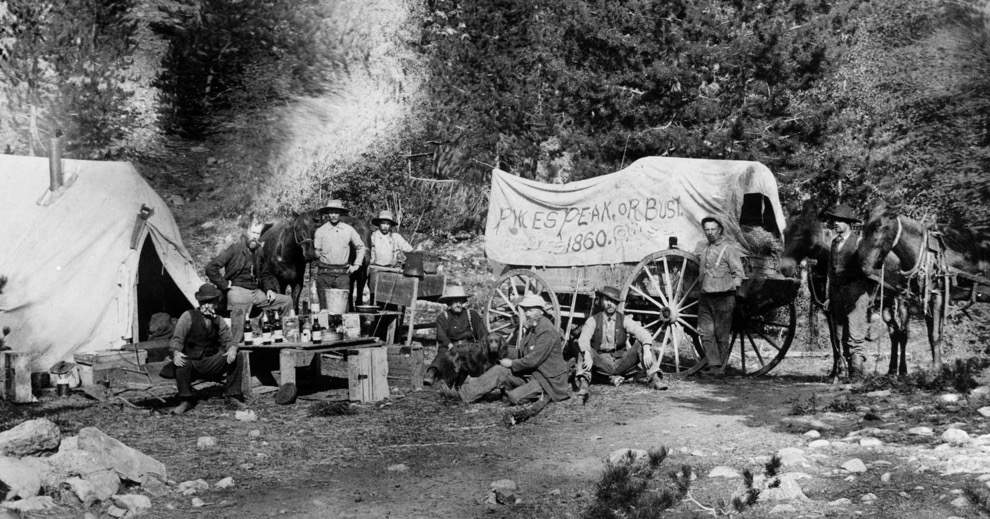Was Thomas Lovewell a 49'er? Was he really part of that vast migratory herd who invaded the West in search of California gold in 1849? If his monument at Lovewell State Park is to be believed, yes he was. If Thomas Lovewell himself is to be believed, no he wasn't. Speaking to a reporter in 1916, he commented that his first great adventure in the New West started as a journey from St. Joe to Pikes Peak in 1859.
It's a good thing he didn't deny going to Pikes Peak, because there seems to be a photo of him posing there with his horse, standing next to his brother Solomon. After taking my first close look at the vintage photograph "Pikes Peak or Bust,” from the Western History/Genealogy Department at the Denver Public Library, I stood up and walked out of the room. Before returning, I made a list in my head of all the reasons why a figure to the left of center probably wasn't him. Stagecoach passengers headed for Denver estimated that they had passed 20,000 travelers clogging the Platte Road that year. Having Thomas turn up in the very first photograph of Pikes Peak prospectors I had ever seen, would be the equivalent of reaching into a haystack chosen at random and immediately pulling out a fistful of needles I hadn't been looking for, then discovering that they were all made of 24-karat gold.

Yet, unmistakably, there he stands, one hand on his hip, scowling at me as if to say, "Took you long enough."
How did this happen? How could we possibly have a picture of Thomas Lovewell standing exactly where he said he had once stood, toward the end of 1859 or the start of 1860? The simplest explanation is that he's incidental to the photograph. He just happened to be passing through when someone famous was having his picture taken. Despite some emulsion damage, the bearded figure resting an arm on his elevated leg appears to be Daniel Chessman Oakes, the cagy entrepreneur whose published guidebook brought a teeming throng of hopeful emigrants to Denver in the first place. The style of this man's coat and his beard, the long watch chain, and the dangling curlicue of hair that reminds some of us of Marlon Brando's Jor-el from "Superman," are all trademarks found in later portraits of Oakes.
Thomas Lovewell didn't say so, but we know that he set out for Pikes Peak from Iowa, as did Oakes, who made several round trips in 1859. In the spring of that year he hauled back a mill from his former home at Glenwood, Iowa, which he installed along a stream near his tent at Riley's Gulch. Another significant figure who set out for Denver from Iowa in 1859 was a man who, like Thomas Lovewell, found little to keep him there, and would push on to California. William Gunnison Chamberlain was a pioneer photographer, known for his early-day views of the Rocky Mountains. He would return to Iowa only long enough to pack up his family and move them to Denver. He quickly established a photographic gallery there, and another at Central City.
Was Chamberlain the man behind the camera in "Pikes Peak or Bust?" If so, did he set up his camera at Riley's Gulch to take a picture of the man who famously started the Pikes Peak craze, or as it came to be known, the Pikes Peak Hoax? Or was William Gunnison Chamberlain, who was born in Massachusetts, distantly related to the John Chamberlain who slew the mighty war chief Paugus during "Lovewell's Fight" in 1825? Or could he have been a descendant of the John Chamberlain who married Captain John Lovewell's niece? The photographer may have decided to record an unexpected Chamberlain/Lovewell reunion, and Oakes is the incidental figure who just happened to be there. All right, probably not.
The man who wound up with the photograph was evidently the one wearing the oversized white hat and suspenders, John Henry Williams, on a prospecting expedition with relatives from Cornwall, the two gents in the bucket hats. It was Williams' grandson, a resident of Central City, who donated the picture to a collection now in the Denver Public Library. It is viewable online as part of of the Library of Congress's virtual collection, American Memory.
There are no identifying marks on the print itself. Guessing who these people are and how they all got there, is a game anyone is allowed to play.